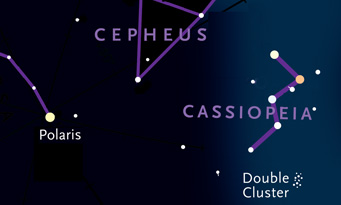Darkness comes sooner now that we’re back to standard time (as of November 4th in the U.S.). The bad news is that daylight is likely gone by the time you get home from work, but the good news for stargazers is that you can grab a quick look at the evening stars before suppertime.
Look high up in the west, and you’ll see the three bright stars of the Summer Triangle. Vega is the brightest and closest to the horizon. Deneb is above it by the width of two or three fists at arm’s length, and Altair is farther off to Vega’s left.

Use the distinctive stars of Cassiopeia to find Polaris, the North Star.
Sky & Telescope diagram
High in the north, well to the right of Polaris, is a group of five medium-bright stars crudely shaped like a “3” or like a broad “W” tipped up on its left corner. This is the constellation Cassiopeia, the Queen. Imagine those stars outlining the chair or throne that she’s sitting on rather than the queen herself.
Although Jupiter rises in mid-evening, this month most of the planetary action is taking place in the predawn sky. In the east, brilliant Venus is unmistakable. Watch for is the steady rise of Saturn up from the twilight glare. On the morning of November 26th Saturn and Venus are separated by less than 1° — so close together that you’ll be able to cover them both with your fingertip.
For more tips to viewing this month's night sky by eye, download November's 6-minute-long audio sky tour.
 0
0
Comments
You must be logged in to post a comment.